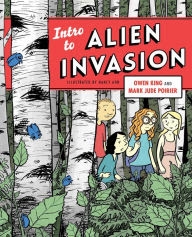THE GRAPHIC NOVEL
 The definition of graphic novels is best explained as book-length comics. They are often a single storyline, flowing from first page to last, and sometimes they are collections of short stories. Graphic novels, like the comic books they parallel, rely to a high degree on visual art. This art is usually combined with text, most often presented in a series of rectangular panels. The definition of graphic novels is best explained as book-length comics. They are often a single storyline, flowing from first page to last, and sometimes they are collections of short stories. Graphic novels, like the comic books they parallel, rely to a high degree on visual art. This art is usually combined with text, most often presented in a series of rectangular panels.
 Comics and the graphic novel evolved from the “funny papers,” enabling a longer story to be told than in the limited space granted by newspaper formats. The name notwithstanding, not all comics are funny. Many emphasize broader themes that feature complex drama and well-developed characterization.
Comics and the graphic novel evolved from the “funny papers,” enabling a longer story to be told than in the limited space granted by newspaper formats. The name notwithstanding, not all comics are funny. Many emphasize broader themes that feature complex drama and well-developed characterization.
Among purists the term graphic novel has become contentious. Since the 1970s, experts in the field have ventured to define comics as an “academic discipline,” worthy of specialization in publishing. A debate over the term “graphic novel” may challenge this definition. To most readers, the word “comic” refers to a publication meant for children, usually available at newsstands or in comic book stores. The term “graphic novel “usually refers to a longer storyline, usually meant for a more mature audience. This format may be published in either paperback or hardback, and be found online, or in bookstores. The graphic novel usually contains more serious themes and more complex artwork than the classic comic book.
These distinctions can become somewhat confusing, because comics come in a variety of shapes and formats, and appeal to many different audiences. Furthermore, comics now explore and wide range of genres and literary styles. Oftentimes, graphic novels contain repackaged collections of previously published comic strips. Even though original material may be produced especially for the graphic novel, it is difficult for booksellers to differentiate between collections and original material, leaving the term “graphic novel” searching for a clear meaning. Perhaps the graphic novel label is no more than a marketing term intended to free those who may be uncomfortable or embarrassed with being identified as a reader of comics intended for a juvenile or sub literate audience.
Additionally, recently published graphic novels can take a more distinct form offering longer original narratives, with obvious differences in style from comics. These volumes may also take advantage of superior production techniques, using higher quality papers and binding formats thereby expanding the distinction between the graphic novel and the comic.
The term graphic novel may be a product of American and British cultural prejudices. The term is not prevalent in Europe or in Japan, where the adult comic coexists quite comfortably with comics for children. People in Japan regularly read comics (called manga), which cover a broad variety of genres and themes.
As the popularity of graphic novels has grown, many main stream and bestselling novelists have been tapped to contribute to the genre. Jim Butcher, Neil Gaiman, Brad Meltzer, Janet Evanovich, Stephenie Meyer, James Patterson, and Dean Koontz are just a few who have penned graphic novels.
Often these new graphic novels are sometimes straight adaptations of popular novels, or more frequently they are original stories based in the prose works or characterizations of well known authors.
By using existing novels, publishers of the graphic novel look to loyal and enthusiastic fan bases, in hopes of bringing in new readers to the comic medium. They also use these adaptations to create “universe-expanding stories,” to increase demand for both series novels and standalone stories.
The familiar format of the graphic novel is less foreboding than the bound book to the new reader. This position can be easily supported by the classic stories that have made their way into this format, exposing readers to such notables as Moby Dick, The Odyssey, Beowulf, Pride and Prejudice, Dracula, and many more.
In February of 2017, with no warning and little explanation, The New York Times decided to stop compiling and printing its Hardcover Graphic Novel, Paperback Graphic Novel and Manga best seller lists. While publishers were shocked and dismayed by this decision, it is doubtful whether this change will slow the growth of this format.
Even without the “lists,” demand for the graphic novel continues to expand. The reader’s buying choices will reflect which titles are most popular. For now, however, no story in the world is probably more important than Frank Miller's The Dark Knight Returns. Released in 1986, it was responsible for the rejuvenation of Batman - and for the comics industry as a whole. It still ranks as the bestselling graphic novel of all time – or is it a comic book? Who cares!?
As always, please feel free to contact [email protected] with any questions you have about books within your existing collection, or those you might consider purchasing. Consider visiting the Ask John or FAQ pages for even more information about book collecting!
We appreciate your comments and questions, and hope that we are a reliable resource for your book collection needs.
Don't forget your book collecting accessories, too!
|
|
|